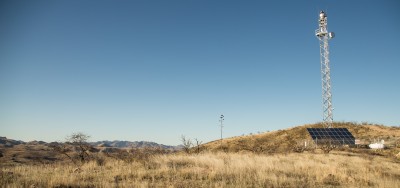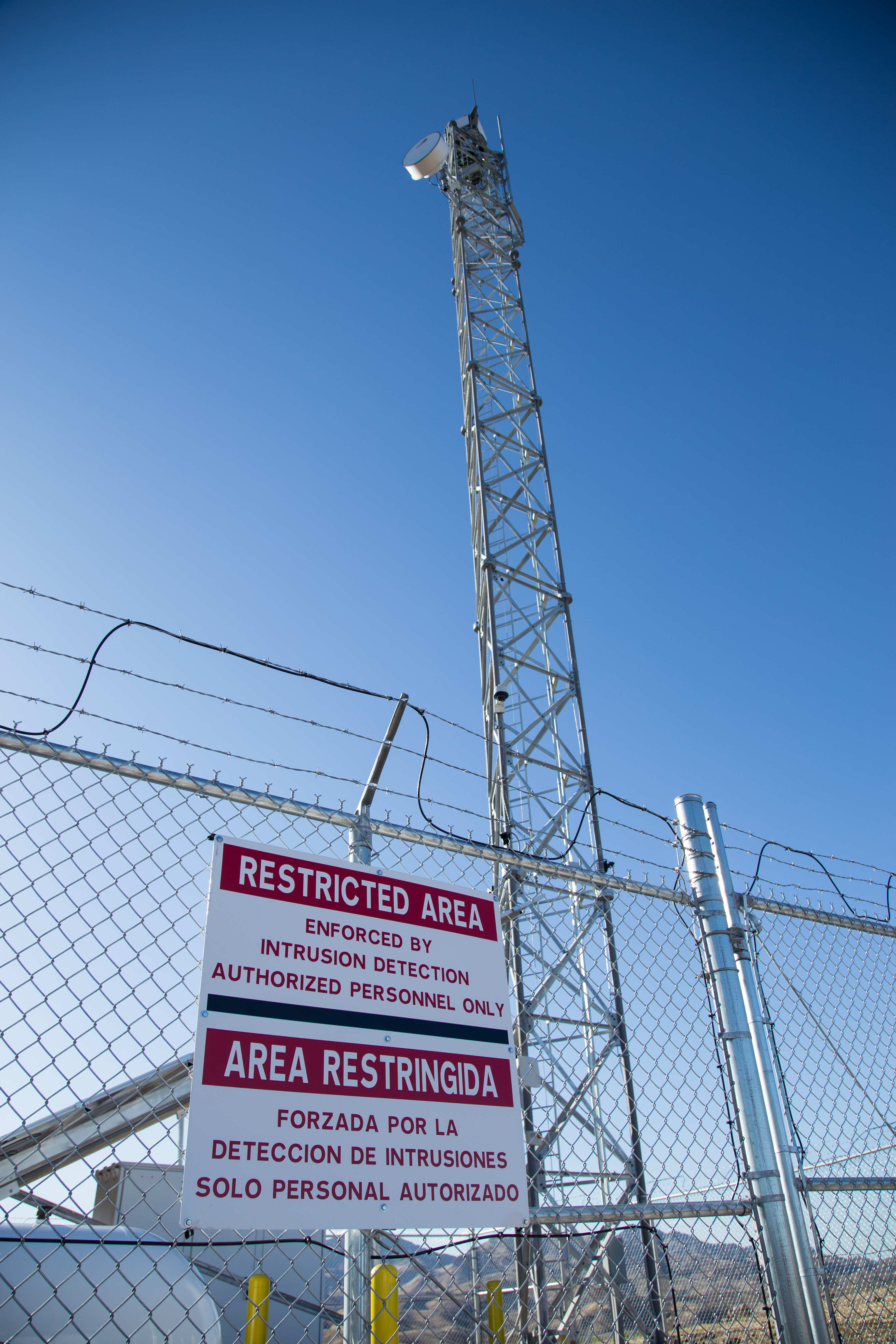From Nogales, Arizona to Ofer Prison: Witnessing Racism in the American and Israeli Borderlands

Image: The border between the United States and Mexico at Nogales, Arizona. (Photo: Bryan MacCormack with Left In Focus)
Camped under a recently erected roadside surveillance tower near the border town of Sasabe, Arizona, a group of hunters stood in a circle. I had seen the tower from a few miles down the highway and come to take a look at the installation first-hand.
“Those towers are for catching illegals,” one man shouted. “Get ‘em the hell out of here!”
Sasabe has become a major border crossing point for migrants attempting to enter the US. Under the Clinton administration in the 1990s, border enforcement became concentrated in urban areas forcing migration to rural areas that require several day journeys through rugged desert that have had fatal consequences for at least 6,000 people. But this count is surely low. It is based on the number of human remains recovered — often a pile of bones that may or may not contain clues to the identities of the victims. Many who have lost their lives in the Arizona deserts will never be found.
“It’s like a balloon,” Maryada Vallet, media coordinator for the humanitarian group No More Deaths observed. “Border Patrol squeezes in one place and the migrations routes are pushed to another.”
I told one of the hunters that I am from Phoenix but I currently work in Israel.
“What do you guys hunt over there” he asked.
Another man blurted out, “They could hunt Muslims!”
Only weeks after Craig Hicks murdered execution-style Deah Barakat, his wife Yusor Abu-Salha and her sister Razan in their Chapel Hill, North Carolina apartment, the hunter’s statement felt particularly chilling.
Image: A surveilance tower is Nogales, Arizona (Photo: Bryan MacCormack with Left In Focus)
In the expanse of the Sonoran desert that stretches from the north of Mexico into southern Arizona, anti-immigrant fervor has made fertile ground to implement systems to sustain racism and inequality. Technologies that Israeli firms developed to enforce Zionism in Palestine are being imported to the US-Mexico border to sustain the disenfranchisement of Mexican and Central American immigrants whose livelihoods have been wiped out by US neoliberal economic policies and imperial misadventures.
The towers the hunter spoke of are being erected by the Israeli weapons giant Elbit Systems, whose Texas-based subsidiary won a $145 million contract with United States Department of Homeland Security Customs and Border Protection to install a system of “Integrated Fixed Tower systems” in southern Arizona. This is the latest piece of Israeli technology to be imported — the Hermes 450 drone already patrols southern Arizona’s skies. This drone is a major component of Israel’s unmanned arsenal whose destructive capabilities I witnessed last summer in the Gaza Strip during Operation Protective Edge which killed 2,319 and injured 11,000 Palestinians.
Over the last two decades, and in particular since 9/11, the United States government has transformed the southern borderlands into migrant killing fields. Often portrayed as an unfortunate consequence of failed border policy, humanitarians on the ground tell a different story.
“The death and suffering that we continue to see today is a direct result of the policy of deterrence by death,” Vallet said. “While Congress can’t agree on legalization for immigrants, killing them at the border has long been a bipartisan effort.”
Indeed, Border Patrol’s policy was written by planning experts from the Department of Defense Center for Low Intensity Conflict (CLIC). The paper recognized the “mortal danger” posed by the environment and that the mountainous desert could be weaponized against migrants as part of a “well-managed border.”
Across the highway from the hunters, a white van operated by G4S — one of the world’s largest private security firms which also operates at Israeli military checkpoints and prisons — was parked on the shoulder. The van was one of many stationed throughout the desert waiting to be filled with migrants who would be sent to detention centers before being processed in Operation Streamline — what locals call “assembly-line injustice.” Initiated in 2005, Streamline proceedings take place on a daily basis in eight locations across the border region, where several dozen Mexican and Central American migrants take plea bargains to avoid felony charges, landing them 30-180 day sentences — disproportionately the latter.
Streamline is part of Border Patrol’s Orwellian-named deterrence policy: the “Consequence Delivery System.” These prison sentences have failed to convince migrants to abandon plans to enter the US despite Border Patrol’s claims. As Tucson-based journalist and author Todd Miller observed, “Heavy-handed enforcement won’t stop people from coming over the border for much deeper reasons.”
Deterrence is foundational in Israeli policy vis-a-vis Palestinians. The Dahiya Doctrine — named for a Beirut suburb that Israel flattened in 2006 — explicitly demands disportionate force to be wielded against civilian populations and infrastructure as collective punishment for resistance. In Israeli political discourse, accusations of harming deterrence are as commonplace as the catchphrase “secure the border” is in the US.
Though Operation Streamline has failed to deter migrants from entering the US, it has been wildly successful in incarcerating them in order to earn profits for private prisons. Indeed, contractual bed quotas oblige the Arizona Department of Corrections to provide prisoners to Corrections Corporation of America (CCA). It was CCA that crafted Arizona’s 2010 anti-immigrant SB1070 legislation which mandated that police check immigration status using racial profiling tactics, thereby increasing Arizona’s supply of undocumented migrants to CCA prisons.
I observed Operation Streamline on January 20th, 2015, in a federal courthouse in downtown Tucson, Arizona. Arizona’s second most populous city, Tucson is considered the liberal counterpart to Phoenix, the conservative megalopolis that sprawls over the Salt River Valley as well as Arizona’s political landscape. Though Tucson is thought of as a liberal hub, what happens five days per week in downtown Tucson is a visibly racist affront to justice and human rights.
Inside the Evo DeConcini Federal Courthouse in downtown Tucson, fifty-six men and four women, all from Mexico and Central America, sat gender-segregated on several rows of benches. Their hands had been cuffed with a chain around their waist, feet shackled, and their shoelaces and belts had been confiscated. All but one prisoner wore the clothes in which they had been apprehended — he had been issued a grey prison jumpsuit.
Echoing a long history of anti-immigrant disease hysteria, hand sanitizer and boxes of tissue sat on each courtroom table and a court employee donned blue rubber gloves to sterilize court-provided earphones for language interpretation. A century ago, agents of US Customs, the precursor to the modern-day Customs and Border Protection, used typhus hysteria as pretext to disinfect Mexican day-laborers coming from Juarez to El Paso with gasoline, DDT and Zyklon B — the chemical used to murder a million people in Nazi Germany’s gas chambers.
In the back of the courthouse, federal marshals hovered over me and a group of University of Arizona student observers, making sure that no one recorded the proceedings. Eight at a time, chained migrants sauntered to the front of the courtroom, silent except for the jingle of their shackles. Standing before Magistrate Judge Eric Markovich, the migrants were flanked by additional US marshals as if they presented a physical threat.
In reality, by the time migrants are rounded up in the desert by Border Patrol, they have been traveling for several days or even weeks with only what they have on their backs and are in immediate need of water, a medical check up and clean clothes.
“It’s like picking up a dehydrated and lost hiker in a tank instead of an ambulance,” Vallet remarked to me.
With Border Patrol supplying a large daily haul of migrants to prosecute, the state has resorted to hiring private lawyers, a lucrative business for local attorneys who earn $125 per hour.
In Streamline’s current format, lawyers spend a few minutes meeting with each migrant before the proceedings, strongly advising them — what some migrants have described as pressuring — to accept a plea bargain that gives up their right to appeal. Worse yet, migrants who have been previously deported face felony charges and prison sentences ranging from 2 to 20 years if they are caught in the US again.
The migrants then stand before the judge, with their lawyers behind them — often whispering answers in their ears. The judge recites a script to each migrant before they are whisked away into holding cells inaccessible to the public before being sent to CCA prisons.
Todd Miller told me this is a recent development — they used to be sentenced en masse.
“I’m sorry that I’m mispronouncing your name. I’m mispronouncing most people’s names ” Judge Markovich said, eliciting audible hisses from a group of University of Arizona students observing the proceedings.
I was reminded of my visits to Ofer Prison, the massive Israeli military prison for Palestinians just inside the occupied West Bank. Only a short drive from Tel Aviv’s vegan cafes, Ofer Prison embodies Israeli apartheid — inside these courts, the military convicts Palestinians at a 99.7% rate. Like Tel Aviv, most Tucsonans will never see the kangaroo courts that are a mere formality in these racist systems.
Inside Ofer Prison, I saw Palestinian-American Mariam Barghouti, then 20 years old, go through a similarly farcical process. Barghouti had been translating for me at a West Bank protest when Israeli soldiers at a checkpoint detained us and crafted a lie on the spot claiming that she had thrown rocks during the protest, hitting one of them on the foot. This was enough for Border Police to kidnap Barghouti and imprison her inside Israel — a violation of international law.
When I saw Barghouti in a dilapidated trailer that served as a courtroom in Ofer Prison, she was shackled like the migrants I would see in Tucson. Conflicting testimony from the soldiers and media attention resulted in Barghouti accepting a plea bargain. But her case was an extremely rare exception. Last month, Lina Khattab, an 18-year-old Palestinian woman, had no such luck when she faced the same charges. The Israeli military court refused to release Khattab even on bail, and she now sits in the Israeli Hasharon prison.
Back in the Tucson courthouse, two grueling hours of repetitive proceedings were coming to a close. The last defendants were from indigenous tribes and did not understand Spanish. Unable to find an interpreter, the court was unable to complete the formalities in order to imprison the two men. In total disregard of the severe reality that pushed the migrants to the US, the judge told them they would be turned over to immigration authorities and returned home.
“For those of you who speak a different dialect, hopefully you understand what I tell you now,” Judge Markovich said.
The men stood silently, unable to understand him.
“It’s very important that you not return illegally to the United States because there is a possibility you could just be charged with a felony and face significant prison time. So please don’t come back to the United States. Gentlemen, best of luck to you.”


